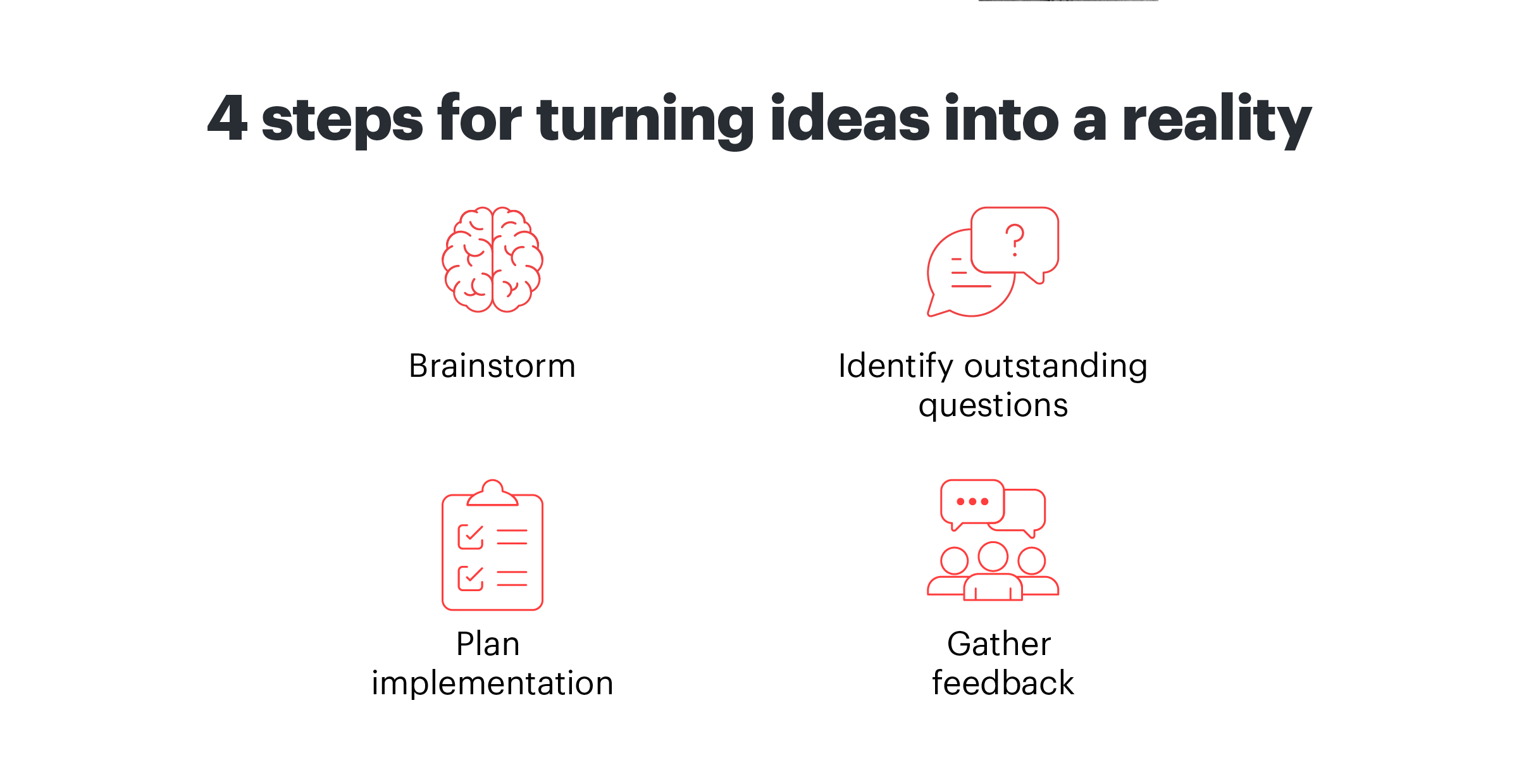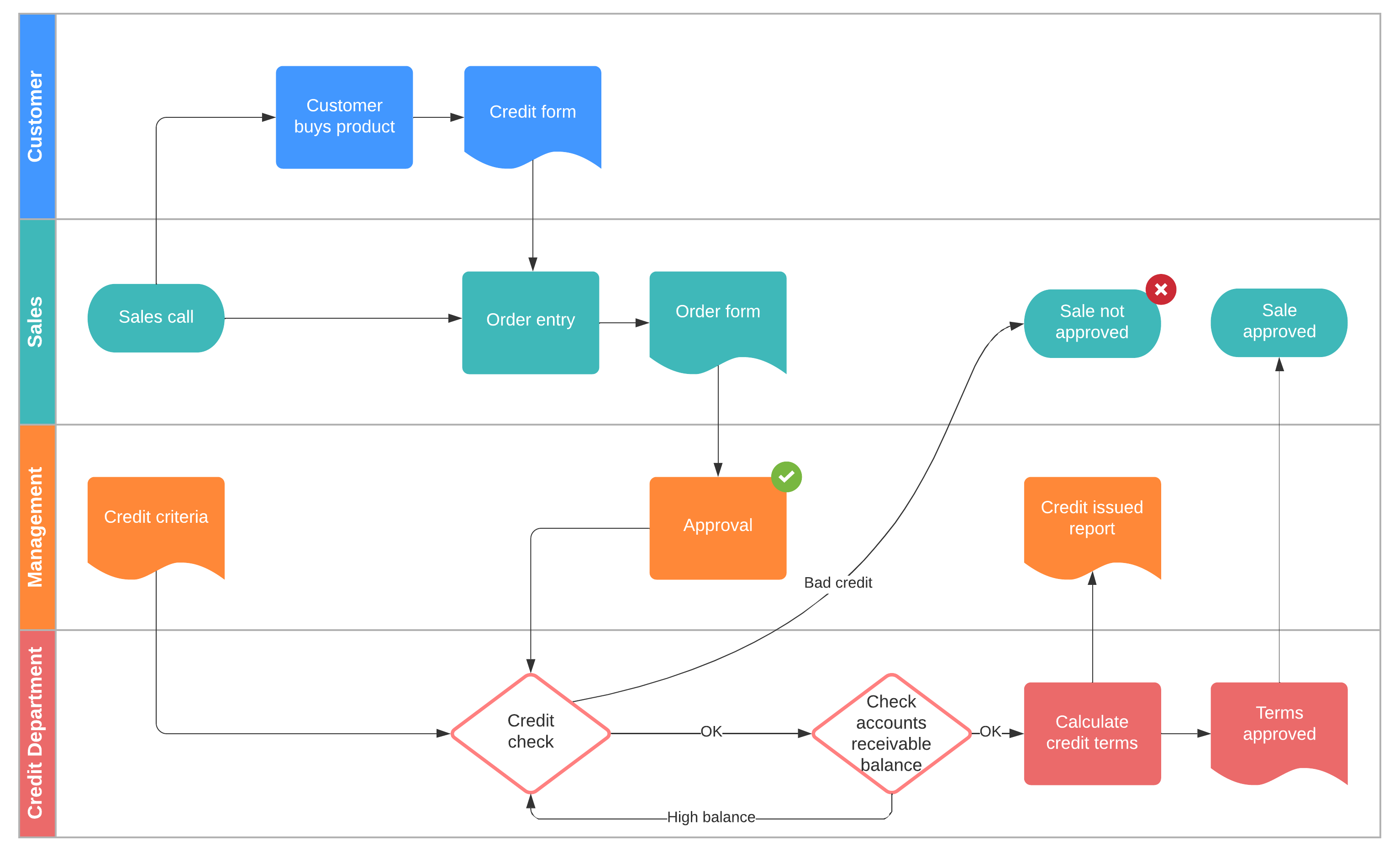A recent university study estimates the average person has more than 6,000 thoughts in a typical day. Among those brief, fleeting, and often random moments, we’ve all had our share of genuinely good ideas. Yet, turning ideas into reality can be an elusive process.
If it’s a product idea for work, we might tell a boss about it. Now it looks like the idea is building up momentum. But then, just as quickly as it seemed you were making progress, it all slips away.
Sometimes it feels like no one knows how to make an idea a reality. Without clear next steps, the excitement for the idea dwindles. Lacking both direction and motivation, the team turns its attention elsewhere. Within weeks, your idea is completely scrapped.
A team’s ability to implement ideas depends on having a process built around executing. There are four steps that teams can use to help generate, define, and realize their ideas. Let’s talk about how to get it done.

Brainstorming
With an effective brainstorm session, turning ideas into reality becomes much easier.
To make the most out of your brainstorming activities with your team, it helps to follow a few guidelines.
First, defer judgment of ideas. Remember, the goal is to consider every possibility and to allow everyone to participate.
Second, go for quantity. Look to build on the ideas of others.
Third, stay focused on the topic. Stick to one conversation at a time.
It also helps to start the brainstorm with a clarifying question to determine the purpose or outcome, such as, “What is the problem or need we’re trying to solve with our idea?”
Other questions that will refine your process of turning ideas into reality include:
- Who will benefit from this new or improved product/service?
- How will they benefit from this new product/service?
- What metrics will measure the success of this product/service?
Once you’ve got several ideas, the next task is reaching a consensus on which ones are best and worthy of further consideration. Using Lucidspark features like voting, emojis, and comments, allow everyone to participate in the decision process and share their opinions. Accessible online, it also encourages real-time interaction between team members working in office or remotely.
Now that you’ve settled on an idea, it’s time to dive in!
Identify outstanding questions
Before you can implement ideas at your organization, you’ll need to identify outstanding questions about the viability of making it happen with your resources and capabilities.
Questions you’ll need to answer include:
- Do we have the budget or means to make this idea happen?
- Do we have the people or expertise to make this idea happen?
- Do we have the time or bandwidth to make this idea happen?
If there are unresolved issues or unknown variables involving any of the factors outlined above, see if you can secure the resources needed to get things moving along. Consider whether it’s realistic at this time to allocate money, hire personnel, or adjust schedules.
Once you know you’ve got the right people and resources, you’re ready to build a game plan.
Plan implementation
The success of any new product, service, or strategy depends on the quality and thoroughness of the implementation plan your team develops.
Your planning process should include:
- Documenting the plan. Use Lucidchart to outline the plan in a visual flowchart to share with your team. This can be a go-to source to check your progress against.
- Assigning a plan owner. Before making individual assignments, decide who will be the one to keep things on track, resolve issues, and lead the plan’s execution.
- Making a risk assessment. Get a better understanding of the pitfalls you’ll likely face before committing to the plan. Gather insights from everyone on the team.
- Establishing the budget. How much is your company willing to invest in the plan? Use similar implementation plans as a baseline but leave yourself wiggle room.
- Delegating the plan tasks. The plan owner not only assigns tasks to members of the team at this step, they’ll also set expectations and define project deliverables.
- Creating a plan schedule. Try for quick and cost-effective while also taking scope creep into account.

Breaking tasks into milestones will keep your team focused on their goal, and they’ll be motivated by the progress they make. This part of the implementation plan is where a great project manager comes in handy, as they guide the team through executing the idea.
Gather feedback
Don’t assume you’ve got all the answers just because the idea started with your team. Learning how to make an idea a reality means benefiting from the experience of others. Gathering feedback and seeking advice from stakeholders and other people from your organization should never be overlooked.
Prepare to explain your idea thoroughly, answer tough questions, and handle criticism. When it comes to critique, try not to take it personally. If it seems constructive and valid, see how you can use it to improve your idea or take things into an entirely new direction.
Some feedback carries greater weight than others. Not everyone will grasp what you’re trying to accomplish. Steve Jobs almost stopped the iPhone’s development because he didn’t see its viability. Because his team persevered, he ultimately warmed to the idea.
This is why it’s critical to ask for clarification on any feedback that doesn’t make sense. Find value in the negative comments or dissenting opinions. But stand behind your idea.
Now that you know ways for turning ideas into reality, it’s time to get those ideas flowing. Try using Lucidspark to brainstorm with your team and discover your next great idea!

Start brainstorming in Lucidspark.
Try it nowAbout Lucidspark
Lucidspark, a cloud-based virtual whiteboard, is a core component of Lucid Software's Visual Collaboration Suite. This cutting-edge digital canvas brings teams together to brainstorm, collaborate, and consolidate collective thinking into actionable next steps—all in real time. Lucid is proud to serve top businesses around the world, including customers such as Google, GE, and NBC Universal, and 99% of the Fortune 500. Lucid partners with industry leaders, including Google, Atlassian, and Microsoft. Since its founding, Lucid has received numerous awards for its products, business, and workplace culture. For more information, visit lucidspark.com.
Related articles
What to do after a brainstorming session
Knowing what to do after a brainstorming session is often more important than getting together to ideate in the first place. If you want to turn a brainstorm into workable ideas, here are some great ways to get started.
Tips and tricks for facilitating ideation sessions in Lucidspark
Here is a set of features and practices you can use—in any combination—to get the most from your team’s brainstorming sessions.
3 key ways to deliver on your ideas
Great ideas happen every day, but bringing them to life is another story. In this article, learn three key ways to deliver on your ideas. Includes a free course!

